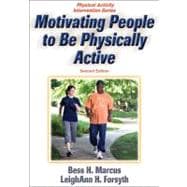
Note: Supplemental materials are not guaranteed with Rental or Used book purchases.
Purchase Benefits
What is included with this book?
| Series Preface | p. xi |
| Preface | p. xiii |
| Acknowledgments | p. xv |
| Theoretical Background and Tools for Measuring Motivational Readiness | p. 1 |
| Describing Physical Activity Interventions | p. 3 |
| Physical Activity Recommendations | p. 4 |
| Definitions of Physical Activity, Exercise, and Physical Fitness | p. 6 |
| Physical Activity Interventions | p. 8 |
| Theoretical Models | p. 9 |
| Motivational Readiness for Behavior Change | p. 10 |
| Conclusion | p. 10 |
| The Stages of Motivational Readiness for Change Model | p. 11 |
| Motivational Readiness and the Stages of Change | p. 12 |
| Match Treatment Strategies to Stages of Change | p. 15 |
| Processes of Behavior Change | p. 16 |
| Conclusion | p. 20 |
| Integrating Other Psychological Theories and Models | p. 21 |
| Learning Theory | p. 22 |
| Decision-Making Theory | p. 25 |
| Behavioral Choice Theory | p. 26 |
| Social Cognitive Theory | p. 28 |
| Ecological Model | p. 29 |
| Relapse Prevention Model | p. 30 |
| Conclusion | p. 32 |
| Putting Theories to Work by Looking at Mediators of Change | p. 35 |
| Consider Mediators of Physical Activity Behavior Change | p. 36 |
| Factors That Enhance Physical Activity | p. 38 |
| Unlock the "Black Box" | p. 46 |
| Conclusion | p. 4 |
| Using the Stages Model for Successful Physical Activity Interventions | p. 49 |
| Imagine Action: A Community-Based Program | p. 50 |
| Jump Start to Health: A Workplace-Based Study | p. 52 |
| Jump Start: A Community-Based Study | p. 54 |
| Project Active: A Community-Based Study | p. 55 |
| Project STRIDE: A Community-Based Study | p. 56 |
| Step Into Motion: A Community-Based Study | p. 56 |
| Conclusion | p. 57 |
| Applications | p. 59 |
| Assessing Physical Activity Patterns and Physical Fitness | p. 61 |
| Discovering Patterns of Physical Activity Behavior | p. 62 |
| Determining Intensity Level | p. 63 |
| Tracking Physical Activity Behavior | p. 65 |
| Assessing Fitness | p. 73 |
| Assessing Physical Activity and Fitness in Group Settings | p. 77 |
| Conclusion | p. 78 |
| Using the Stages Model in Individual Counseling | p. 79 |
| Physical Readiness | p. 80 |
| Physical Activity History | p. 82 |
| Psychological Readiness | p. 82 |
| Confidence | p. 89 |
| Set Short- and Long-Term Goals | p. 90 |
| Measure Success | p. 91 |
| Conclusion | p. 108 |
| Using the Stages Model in Group Counseling Programs | p. 109 |
| Leading a Stage-Based Group | p. 110 |
| Learning From a Sample Stage-Based Curriculum | p. 115 |
| Assessing Your Effectiveness as a Leader | p. 118 |
| Conclusion | p. 128 |
| Using the Stages Model in Work Site Programs | p. 129 |
| Building Support for Your Program | p. 131 |
| Assessing Motivational Readiness | p. 131 |
| Choosing Your Target Audience | p. 132 |
| Reaching Your Target Audience | p. 133 |
| Developing Stage-Matched Materials | p. 134 |
| Focusing on Moderate-Intensity Activity | p. 135 |
| Planning Events | p. 135 |
| Adding Incentives for Participation | p. 136 |
| Conclusion | p. 146 |
| Using the Stages Model in Community Programs | p. 147 |
| Assessing the Community's Readiness for Change | p. 149 |
| Reaching Individuals Within a Community | p. 151 |
| Developing Stage-Matched Messages | p. 152 |
| Using a Media-Based Approach to Reach Your Target Audience | p. 154 |
| Working With Community Leaders to Reach Your Target Audience | p. 156 |
| Conclusion | p. 166 |
| Questionnaires | p. 167 |
| Resources | p. 177 |
| References | p. 181 |
| Index | p. 193 |
| About the Authors | p. 199 |
| Table of Contents provided by Ingram. All Rights Reserved. |
The New copy of this book will include any supplemental materials advertised. Please check the title of the book to determine if it should include any access cards, study guides, lab manuals, CDs, etc.
The Used, Rental and eBook copies of this book are not guaranteed to include any supplemental materials. Typically, only the book itself is included. This is true even if the title states it includes any access cards, study guides, lab manuals, CDs, etc.